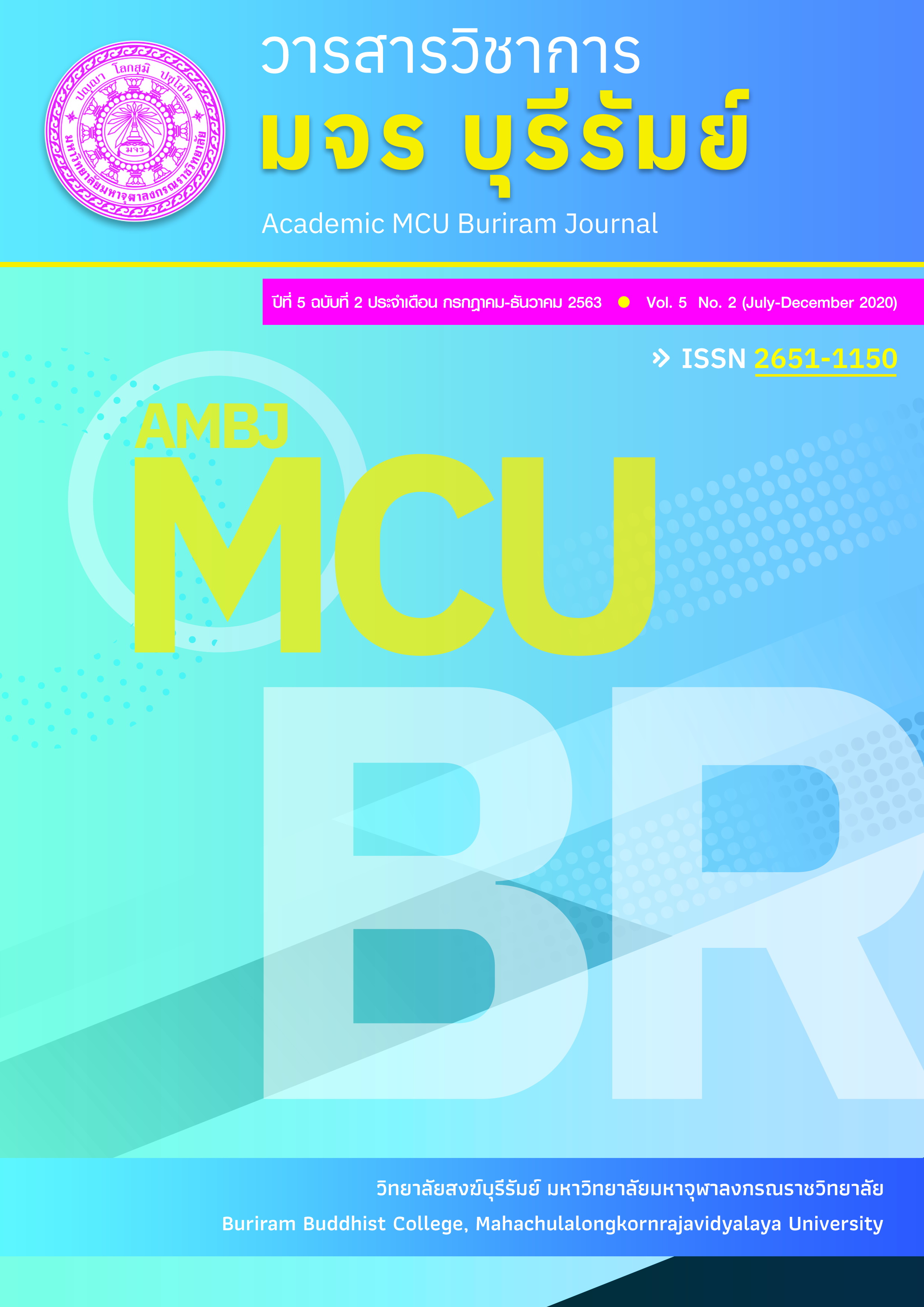Legal Measures Regarding the Protection of Religious Properties of Temples in Theravada Buddhism in Thailand
Keywords:
Law Measure, Protection for Religious Properties of Temples, Theravada BuddhismAbstract
The objectives of research titled “Legal Measure regarding the Protection of Religious Properties of Temples in Theravada Buddhism in Thailand,” were: 1) to search for related theoretical approaches of caring, maintaining, and managing the religious properties of temples, 2) to analyze the law in caring, maintaining, and managing the religious properties of temples based on the monks’ Act and power as well as responsibility in managing the religious properties of National Buddhism Office, 3) to compare the law in caring, maintaining, and managing the religious properties of temples between international religious and Theravada Buddhism in Thailand, and 4) to set up the rule and regulation of law in caring, maintaining, and managing the religious properties of temples in Theravada Buddhism in Thailand.
The research methodology of this study was Qualitative Research. Data were collected by the In-depth Interview consisted of the key informants, selected by Purposive Sampling through the interview of the experts including 25 persons of the discipline, law, and practitioner participated in managing the religious properties of temples, and 10 persons participated in Focus Group Discussions.
The research findings found that:
- The related theoretical approaches of law in in caring, maintaining, and managing the religious properties of temples in both of Christianity and Islam were emphasized on religious moral principle and doctrine. The legal measures were established as practical guidelines. In addition, the theoretical approaches of Theravada Buddhism were caring, maintaining, and managing the religious properties of temples based on Buddha’s moral principle and doctrine in bible and Buddha’s teaching divided into three parts, Buddhist Scriptures very strictly. They were fostered and supported by the King Institution from the past to present time, being emphasized on principle based on the Monks’ Act in 1962 or B.E. 2505, the Revised Act by the Monks’ Act (the second issue) B.E. 2535, and the second issue of Ministerial Regulations (B.E. 2511), issued by the Monk’s Act B.E. 2505.
- According to the analysis of the law in caring, maintaining, and
managing the religious properties of temples (the second issue) B.E. 2535 found that there were problem and obstacle in Section 40, Space 2, regulated that “the religious properties of temples were any one’s temple,” and Space 3, regulated that “the caring, maintenance, and management in religious properties of temples were based on specified technique in Ministerial Regulations.” The enforcements were nor efficient in 3 problem issues including: the law of temple ground, law of properties from donation, and slaw of subsidy. The problems caused by technique in provision of law as well as practitioner’s power and duty including the Office of Buddhism and Abbot.
- According to comparison of law regarding to the caring, maintenance, and management of religious properties of temples in Theravada Buddhism of Myanmar and Sri lanka, found that both of Myanmar and Sri lanka established the Act regulated and determined the Buddhism as their national religious. The law was based on discipline strictly. The religious properties of temples were protected by prohibiting to sell or transfer. Besides, the religious properties of temples were for public benefit. Theravada Buddhism in Thailand established too much of laws based on monks’ Act (the second issue) B.E. 2535, and related laws such as the Land Law as well as Civil and Commercial Code. However, the Act, Ministerial Regulations, and Sangha Supreme Council did not specify the process in investigation and implementation of authorities and practitioners in the temples to lead to the practitioner’s responsibility.
4. It was necessary to implement the supplementary law based on the monks’ Act (the second issue) B.E. 2535 by establishing the correct, quick, fair, transparent, and accountable regulation or measure regarding to the appointment of abbot or churchwarden as well as law measure for controlling, caring, and managing the benefit in order to obtain the most benefit for Buddhism truly.
References
กรมการศาสนา. (2542). คู่มือพระสังฆาธิการว่าด้วยพระราชบัญญัติ กฎ ระเบียบและคำสั่งคณะสงฆ์. กรุงเทพฯ: โรงพิมพ์กรมการศาสนา.
กรมศิลปากร. (2519). ศิลาจารึกสุโขทัย หลักที่ 1 ด้าน 2. กรุงเทพฯ: โรงพิมพ์มหาวิทยาลัยรามคำแหง.
กนก แสนประเสริฐ. (2559). เอกสารคู่มือว่าด้วยประมวลพระราชบัญญัติคณะสงฆ์. กรุงเทพฯ: โรงพิมพ์สำนักงานพระพุทธศาสนาแห่งชาติ.
ชาญชัย แสวงศักดิ์. (2551). คำอธิบายกฎหมายปกครอง. พิมพ์ครั้งที่ 14. กรุงเทพฯ: สำนักพิมพ์มหาวิทยาลัยรามคำแหง.
เชค มุฮัมมัด อัลอะมีน อัชชังกีฎีย์. (2552). อิสลามศาสนาที่สมบูรณ์. พิมพ์ครั้งที่ 2. กรุงเทพฯ: นัทชา พริ้นติ้ง.
ปลื้ม โชติษฐยางกูร. (2553). คำบรรยายกฎหมายคณะสงฆ์. กรุงเทพฯ: โรงพิมพ์มหาจุฬาลงกรณราชวิทยาลัย.
ประมาณเลิศ อัจฉริยปัญญากุล. (2552). กฎหมายสำหรับพระสงฆ์. กรุงเทพฯ: โรงพิมพ์มหาวิทยาลัยมหาจุฬาลงกรณราชวิทยาลัย.
พระมหาวีระชัย ชยวีโร. (2556). การพัฒนาประสิทธิภาพการจัดการศาสนสมบัติวัดของคณะสงฆ์ไทย. วิทยานิพนธ์พุทธศาสตรดุษฎีบัณฑิต. บัณฑิตวิทยาลัย: มหาวิทยาลัยมหาจุฬาลงกรณราชวิทยาลัย.
พระมหาสุนันท์ สุนนฺโท. (2558). การพัฒนารูปแบบการจัดการศาสนสมบัติของวัดในจังหวัดพระนครศรีอยุธยา. วิทยานิพนธ์พุทธศาสตรดุษฎีบัณฑิต. บัณฑิตวิทยาลัย: มหาวิทยาลัยมหาจุฬาลงกรณราชวิทยาลัย.
พิพัฒน์ พสุธารชาติ. (2549). รัฐกับศาสนา บทความว่าด้วยอาณาจักรศาสนจักรและเสรีภาพ. พิมพ์ครั้งที่ 2. กรุงเทพฯ: สำนักพิมพ์ศยาม.
สมบูรณ์ สุขสำราญ. (2557). พุทธศาสนากับการเปลี่ยนแปลงทางการเมืองและสังคม. กรุงเทพฯ: สำนักพิมพ์แห่งจุฬาลงกรณ์มหาวิทยาลัย.
สำนักงานพระพุทธศาสนาแห่งชาติ. (2554). คู่มือการดูแลและการจัดการศาสนสมบัติ. กรุงเทพฯ: โรงพิมพ์สำนักงานพระพุทธศาสนา.
องค์การค้าของคุรุสภา. (2533). พระราชพงศาวดารกรุงศรีอยุธยา เล่ม 1 ฉบับพระจักรพรรดิพงษ์ (จาด). กรุงเทพฯ: ศาสนา.
พระมหาประนอม ธมมธีสงกาโร. (28 มีนาคม 2562). สัมภาษณ์.
พระมหาจรูญ จรณธมโม. (10 เมษายน 2562). สัมภาษณ์.
พระโสภณพัฒนบัณฑิต. (14 เมษายน 2562). สัมภาษณ์.
Downloads
Published
How to Cite
Issue
Section
License
ทัศนะและความคิดเห็นที่ปรากฏในบทความวารสารฉบับนี้ถือเป็นความรับผิดชอบของผู้เขียนบทความนั้น ไม่ถือเป็นทัศนะและความรับผิดชอบของบรรณาธิการ





